Paternity leave – more than 80% know the system, less than 30% take it
TOKYO, June 17, 2022—en world Japan K.K., Japan’s global talent recruitment leader, today announced the results of its Childcare
Leave Awareness Survey in celebration of Father’s Day 2022. The survey was conducted with 1103 global staff working at foreign-affiliated companies and Japanese global companies, and it raised awareness about important company policies that benefit both fathers and mothers.
Summary of Survey Results
-
Paternity leave – more than 80% know of the system, less than 30% take it
-
Actual leave duration is far from the ideal. More than 10% of both mothers and fathers would like “more than 2 years.”
-
“Corporate system set-up” and “support of superiors” are drivers for leave take-up.
-
Men worry over “family finances,” women fret about “post-return career.”
-
Taking maternity leave is a major challenge for female managers.
-
More than 70% want paternity leave. Roll-out of remote working is an alternative.
Overview
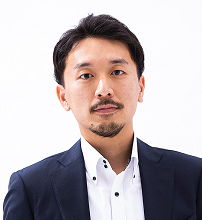
Shin Arita, Talent Acquisition & OD Manager, HR Division
I think the main points raised by this childcare leave awareness survey are “knowledge about the system” and “company culture needed to drive the implementation.”Nearly 50% of men say that they know of the (childcare leave) system itself, but don’t know the duration of the leave. This suggests that more needs to be done to make the system contents better known before they can start using the system. Furthermore, one of the big differences between male and female employees regarding the ease of taking leave is whether the colleagues around them are also utilizing the system. From now on, the presence of initiatives aimed at urging employees to take childcare leave will surely have a big effect on the take up rate of paternity leave at each company.
I have myself enjoyed the fantastic experience of taking 6 months paternity leave. Separated from work, and able to spend time close to my child, not only changed the way I looked at childcare, but I also think it changed the way I communicated, as my wife and I shared all the child raising activities together. I read a survey that found the time spent by a father with his child is about 3 years and 4 months (for mothers it is 7 years and 6 months). The opportunity that we get to take childcare leave is really a very limited one. I therefore hope that each company will promote an organizational culture that increases the rate of employees taking paternity leave.
Data Analysis and Commentary
1. Paternity leave – more than 80% know of the system, less than 30% take it
Responding to a general question about the Child Care and Family Care Leave Act, over 80% were aware of the system itself, both for paternity leave (83%) and maternity leave (87%). On the other hand, less than half (35% and 46% respectively) were aware of the maximum
length of childcare leave that can be taken. See Figure 1.
Figure 1. Awareness about taking paternity/maternity leave for care of children up to 2 years old
(in accordance with the Child Care and Family Care Leave Act(April 2022 revision))
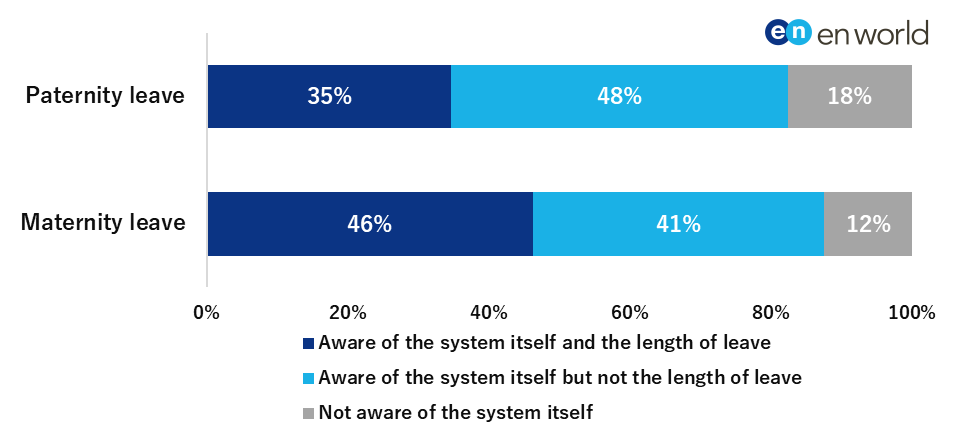
Next, a big gap was seen between the sexes regarding actual utilization of a company’s childcare leave system after the respondent, or their spouse, had given birth. Utilization of maternity leave was around 80% but paternity leave uptake was less than 30%. Of those who
answered that paternity leave was not taken, nearly 30% said this was due to the company not having a childcare leave system in place, indicating that some companies may have issues with their institutional structure. See Figure 2.
Figure 2. Utilization of company childcare leave system after oneself (or spouse) gave birth
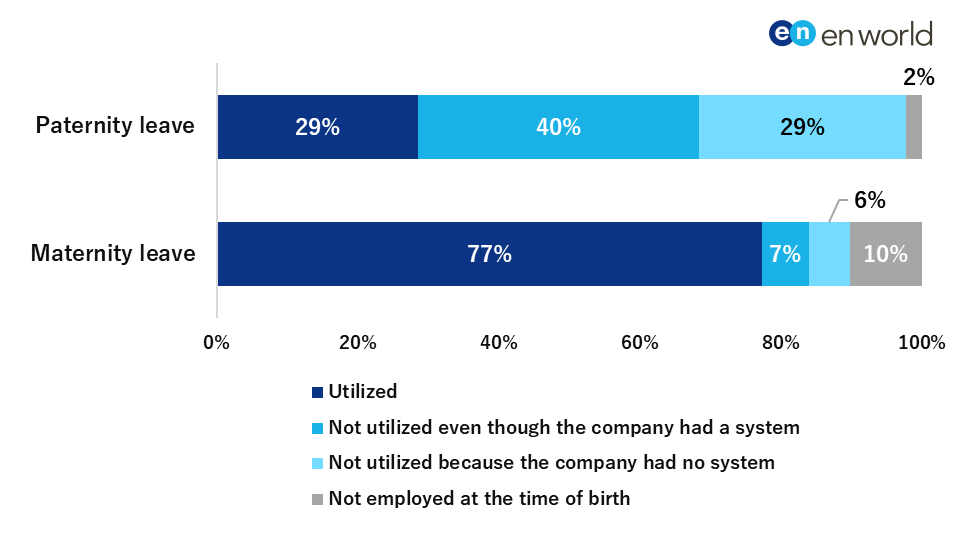
2. Actual leave duration is far from the ideal. More than 10% of both mothers and fathers would like more than 2 years.
Among those who took childcare leave, the length of paternity leave was most commonly between 1 - 3 months (25% of respondents), followed by less than 1 week (18%). On the other hand, the duration of maternity leave was most commonly 6 - 12 months (48%), then 12 - 18 months (26%), revealing a big difference between the sexes. See Figure 3.
Figure 3. Length of childcare leave taken
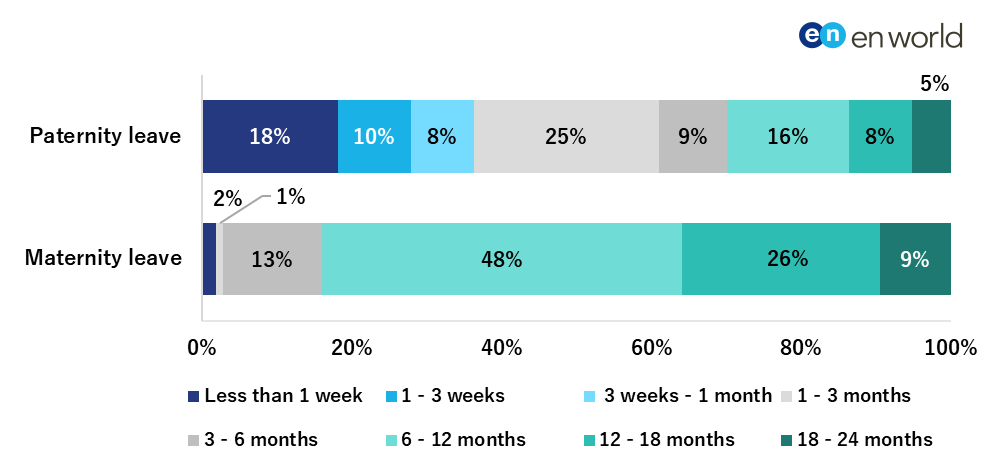
Next, childcare users were asked about the ideal length of childcare leave.Among the most popular replies regarding paternity leave, 20% thought 1 - 3 months, with 19% favoring 6 - 12 months. In the case of maternity leave, 6 - 12 months and 12 - 18 months were equal top in popularity with 31% each.Both sexes indicated a desire to have longer childcare leave than actually taken, with more than 10% of each sex wishing to have in excess of the current 24 month maximum. Furthermore, whilst 30% actually took less than 3 weeks paternity leave, less than 5% feel that is the ideal length. See Figure 4.
Figure 4. Opinion on ideal length of childcare leave
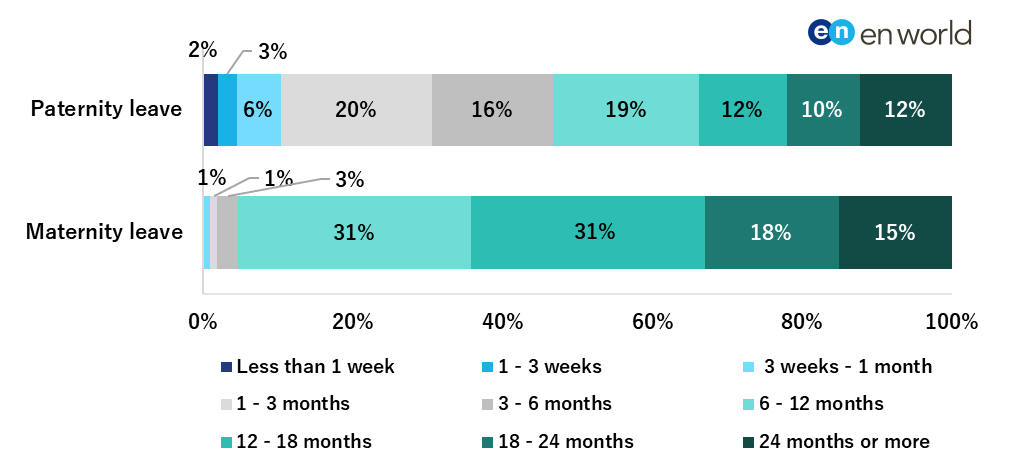
3. “Corporate system set-up” and “support of superiors” are drivers for leave take up
Close to 70% of both sexes felt their surrounding environment assisted them to take childcare leave. See Figure 5.
Figure 5. Influence of surrounding environment on ease of taking childcare leave
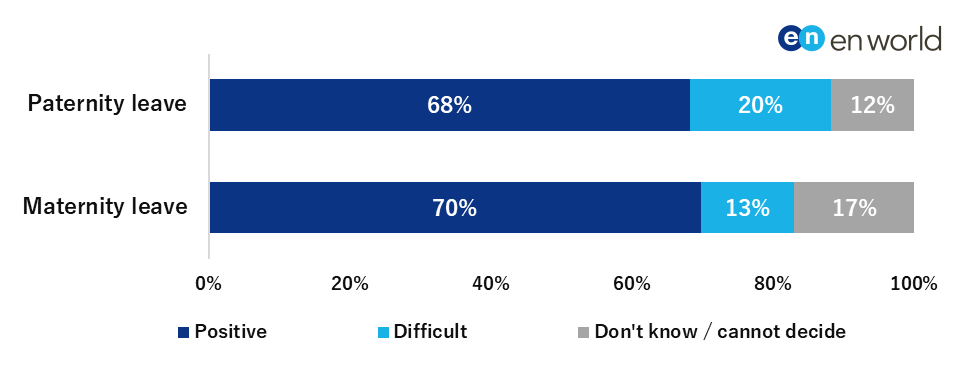
These respondents cited “the existence of a company childcare leave system, making it easy to understand” (78%), followed
by “understanding and support from superiors” (73%), as the main reasons for their positive reply. Most of those who said leave taking “felt natural because other colleagues were doing the same” were referring to maternity leave (51%), with paternity leave lagging more than
15 points behind on 35%. This is reflected in the lower utilization rate of paternity leave compared to maternity leave. See Figure 6.
Figure 6. Main reasons for answering “positive” in Figure 5 (multiple selections possible)
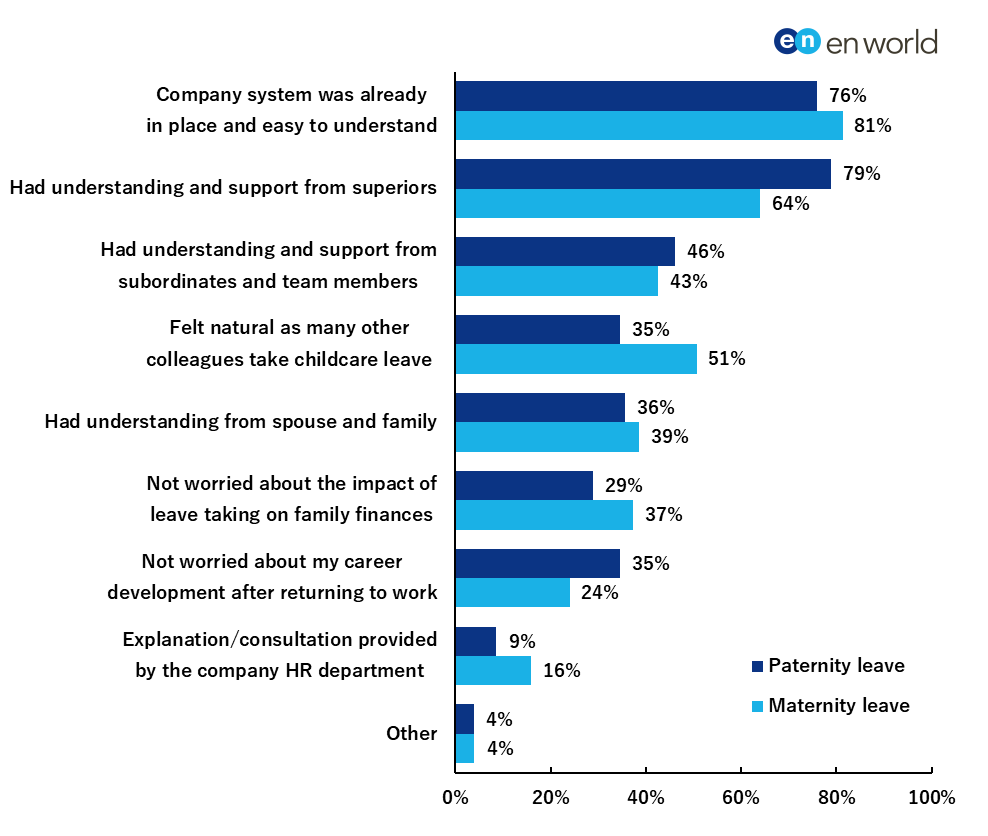
4. Men worry over “family finances," women fret about “post-return career”
In contrast, “insufficient understanding and support from superiors” (64%), followed by “childcare leave is not commonly taken by other colleagues” (59%), were the main reasons given when answering “difficult” in Figure 5. Some other reasons are dependent on gender. “Unease about my career after returning to work” was the second biggest reason connected to maternity leave (64%).This indicates that females worry more about their careers because they have a relatively long time away from work. For paternity leave however, 37% cited “worry about the impact of leave taking on family finances”, indicating that taking childcare leave is a major challenge for men that are financially supporting their families. See Figure 7.
Figure 7. Main reasons for answering “difficult” in Figure 5 (multiple selections possible)
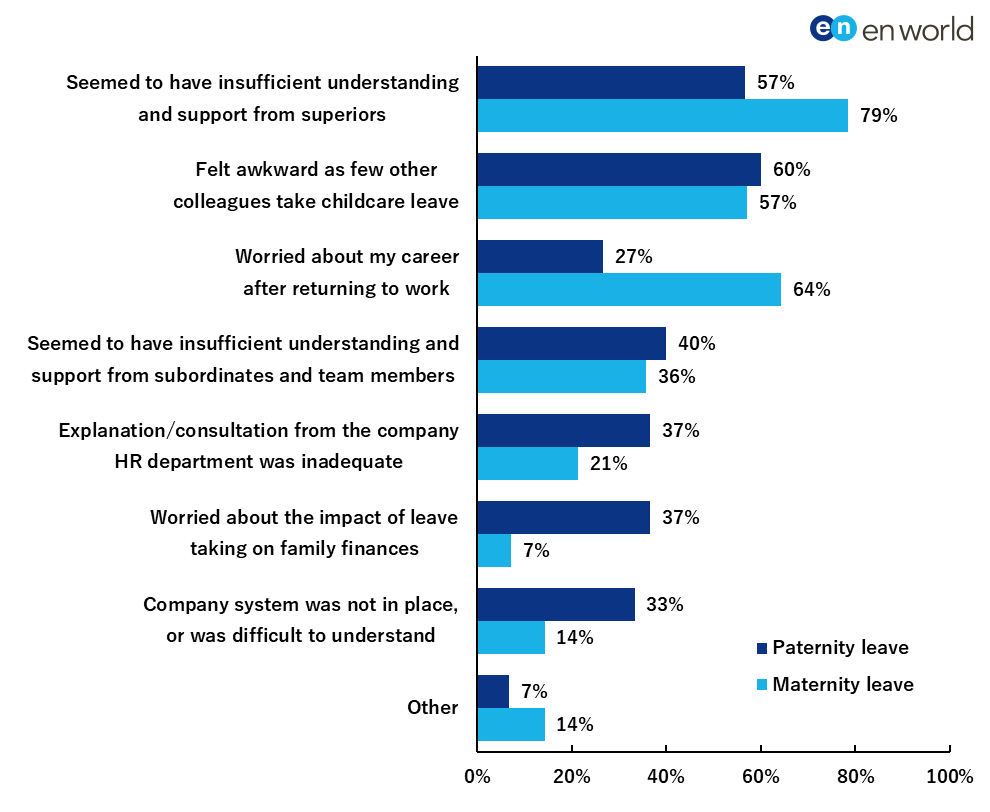
5. Taking maternity leave is a major challenge for female managers
“Worry over the impact of leave taking on family finances” was, at 33%, the biggest reason given for not utilizing an existing company paternity leave scheme when their child was born, (see Figure 2). In contrast, “a lack of understanding and support from subordinates and team members” was the most common response related to maternity leave (44%). As this comment was frequently made by female department or section managers, it indicates that the taking of childcare leave is a major challenge for women in managerial roles. See Figure 8
Figure 8. Main reasons for not using the system already installed by the company (see Figure 2)
(multiple selections possible)
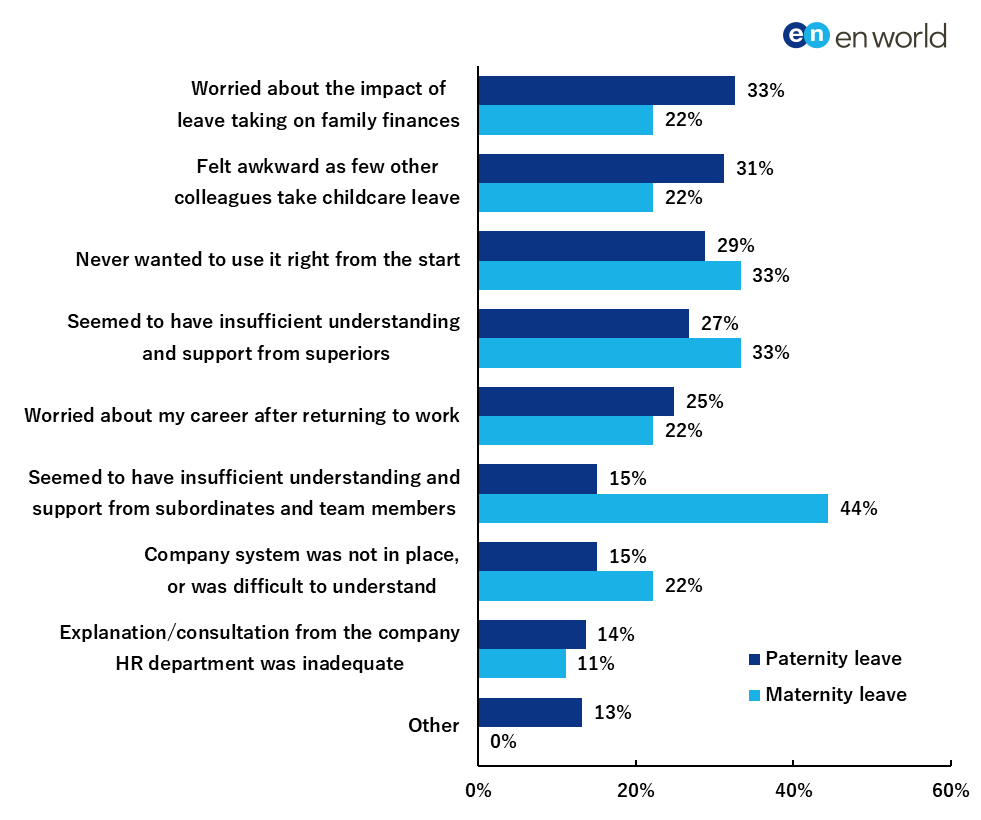
6. More than 70% want paternity leave. Roll-out of remote working is an alternative.
For both sexes, more than 70% of respondents indicated a desire to take advantage of paternity leave if they (or their spouse) gave birth in the future. (including those who have already done so). See Figure 9.
Figure 9. Desire to utilize paternity leave if having a child in the future
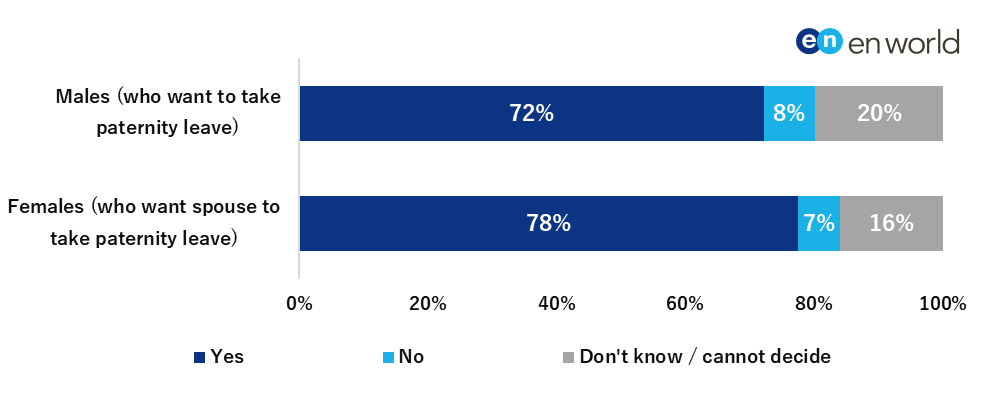
Among those men who want paternity leave, the biggest reason (77.9%) was “after my wife has had a baby, I need to do housework and childcare myself.” In contrast, 43.6% of those men opposed to taking paternity leave said that remote working already allowed them to take
part in childcare without needing to take leave. See Figure 10
Figure 10. Main reason(s) for answer given in Figure 9.
(male respondents only, multiple selections possible)
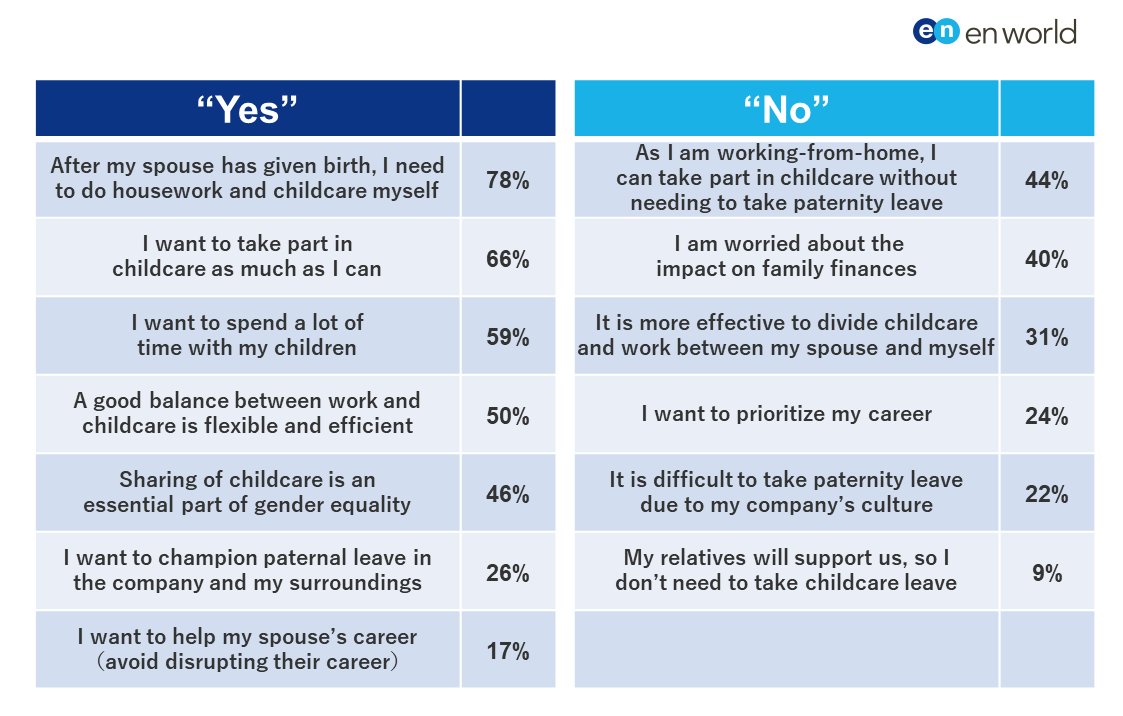
Outline of the survey
Survey method: Internet survey
Surveyed regions: Nationwide in Japan
Survey period: June 3–10, 2022
Number of respondents: 1,103
Respondents' company affiliation: 45% Foreign company employees / 55% Japanese company employees
Response format: Single and multiple responses
▼Download PDF
Childcare leave awareness survey_20220617.pdf
About en world Japan:
Founded in 1999, en world Japan has now grown into one of Japan’s leading talent acquisition and management firms today, with reach across Asia. We support both foreign-affiliated companies and Japanese companies to connect with internationally-minded candidates, in particular to middle and senior management positions. Our exclusive Total Talent Engagement is designed to make talent acquisition more efficient and systematic by utilizing our world-class network and in-house database to find the ideal match for each organization and working professional.
Press Contacts
PR & Communications, en world Japan
E-mail: enworld-pr@enworld.com
